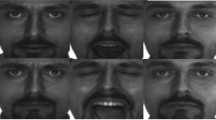Abstract
The selection of kernel function and its parameter influences the performance of kernel learning machine. The difference geometry structure of the empirical feature space is achieved under the different kernel and its parameters. The traditional changing only the kernel parameters method will not change the data distribution in the empirical feature space, which is not feasible to improve the performance of kernel learning. This paper applies kernel optimization to enhance the performance of kernel discriminant analysis and proposes a so-called Kernel Optimization-based Discriminant Analysis (KODA) for face recognition. The procedure of KODA consisted of two steps: optimizing kernel and projecting. KODA automatically adjusts the parameters of kernel according to the input samples and performance on feature extraction is improved for face recognition. Simulations on Yale and ORL face databases are demonstrated the feasibility of enhancing KDA with kernel optimization.







Similar content being viewed by others
References
Li J-B, Pan J-S, Chu S-C (2008) Kernel class-wise locality preserving projection. Inf Sci 178(7):1825–1835
Ma B, Qu H-y, Wong H-s (2007) Kernel clustering-based discriminant analysis. Pattern Recognit 40(1):324–327
Wu X-H, Zhou J-J (2000) Fuzzy discriminant analysis with kernel methods. Pattern Recognit 39(11):2236–2239
Belhumeur PN, Hespanha JP, Kriegman DJ (1997) Eigenfaces vs. Fisherfaces: recognition using class specific linear projection. IEEE Trans Pattern Anal Mach Intell 19(7):711–720
Chawla MPS (2008) Segment classification of ECG data and construction of scatter plots using principal component analysis. Int J Mech Med Biol (JMMB), WSPC 8(3):421–458
Chawla MPS (2007) Parameterization and correction of electrocardiogram signals using independent component analysis. Int J Mech Med Biol (JMMB), WSPC 7(4):355–379
Chawla MPS, Verma HK, Kumar V (2008) Artifacts and noise removal in electrocardiograms using independent component analysis. Int J Cardiol 129(2):278–281
Chawla MPS (2008) A comparative analysis of principal component and independent component techniques for electrocardiograms. Int J Neural Comput Appl (NCA), Springer (available online 23-7-2008)
Chawla MPS, Verma HK, Kumar V (2008) A new statistical PCA–ICA algorithm for location of R-peaks in ECG. Int J Cardiol 129(1):146–148
Lu J, Plataniotis KN, Venetsanopoulos AN (2003) Face recognition using kernel direct discriminant analysis algorithms. IEEE Trans Neural Netw 14(1):117–226
Müller KR, Mika S, Rätsch G, Tsuda K, Schölkopf B (2001) An introduction to kernel-based learning algorithms. IEEE Trans Neural Netw 12:181–201
Liu Q, Lu H, Ma S (2004) Improving kernel fisher discriminant analysis for face recognition. IEEE Trans Pattern Anal Mach Intell 14(1):42–49
Baudat G, Anouar F (2000) Generalized discriminant analysis using a kernel approach. Neural Comput 12:2385–2404
Ruiz A, López de Teruel PE (2001) Nonlinear kernel-based statistical pattern analysis. IEEE Trans Neural Netw 12:16–32
Lu JW, Plataniotis K, Venetsanopoulos AN (2003) Face recognition using kernel direct discriminant analysis algorithms. IEEE Trans Neural Netw 14(1):117–126
Liang ZZ, Shi PF (2005) Uncorrelated discriminant analysis using a kernel method. Pattern Recognit 38(2):307–310
Liang Z, Shi P (2004) Efficient algorithm for kernel discriminant anlaysis. Pattern Recognit 37(2):381–384
Huang J, Yuen PC, Chen W-S, Lai JH (2004) Kernel Subspace LDA with optimized kernel parameters on face recognition. In: Proceedings of the sixth IEEE international conference on automatic face and gesture recognition
Wang L, Chan KL, Xue P (2005) A criterion for optimizing kernel parameters in KBDA for image retrieval. IEEE Trans Syst Man Cybern B Cybern 35(3):556–562
Chen W-S, Yuen PC, Huang J, Dai D-Q (2005) Kernel machine-based one-parameter regularized fisher discriminant method for face recognition. IEEE Trans Syst Man Cybern B Cybern 35(4):658–669
Micchelli CA, Pontil M (2005) Learning the kernel function via regularization. J Mach Learn Res 6:1099–1125
Lanckriet G, Cristianini N, Bartlett P, Ghaoui LE, Jordan MI (2004) Learning the kernel matrix with semidefinte programming. J Mach Learn Res 5:27–72
Dai G, Yeung D-Y (2007) Kernel selection for semi-supervised kernel machines. In: Proceedings of the 24th international conference on machine learning, pp 1457–1465
Xiong H, Swamy MNS, Ahmad MO (2005) Optimizing the kernel in the empirical feature space. IEEE Trans Neural Netw 16(2):460–474
Amari S, Wu S (1999) Improving support vector machine classifiers by modifying kernel functions. Neural Netw 12(6):783–789
Li H, Jiang T, Zhang K (2006) Efficient and robust feature extraction by maximum margin criterion. IEEE Trans Neural Netw 17(1):157–164
Samaria F, Harter A (1994) Parameterisation of a stochastic model for human face identification. In: Proceedings of 2nd IEEE workshop on applications of computer vision
Graham DB, Allinson NM (1998) Face recognition: from theory to applications. Comput Syst Sci 163:446–456
Author information
Authors and Affiliations
Corresponding author
Rights and permissions
About this article
Cite this article
Li, JB., Pan, JS. & Lu, ZM. Kernel optimization-based discriminant analysis for face recognition. Neural Comput & Applic 18, 603–612 (2009). https://doi.org/10.1007/s00521-009-0282-y
Received:
Accepted:
Published:
Issue Date:
DOI: https://doi.org/10.1007/s00521-009-0282-y




